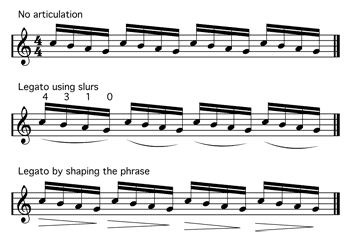Articulation
Articulation is how successive notes in a phrase are "joined together" or "separated" to give the phrase a sense of urgency or relaxation that is over and above "conveying the mood by the speed of playing".
Articulation denotes the change to normal playing to legato (smooth playing) and staccato (detatched playing)
Normal playing
In guitar, all notes die away starting at the moment they are sounded.
In a succession of notes all played at the same volume, the start of each new note is very clear, since it is, by definition, louder than the (already-decaying) previous note.
Legato
Legato - literally "bound" - is when notes have an almost invisible gap between them.
In addition to the word legato as a performance indication, the slur sign can be used to call up a smooth and unobtrusive start to the second note.
- On a piano or organ, legato may actually involve a fraction of a second's overlap between the old note and the new, especially on a Church Organ which takes a while to "speak" a new note
- On a wind instrument, the second note is not tongued, but simply continues from the first. Legato is difficult on brass instruments if the jump between the notes is large because the lip has to suddenly change tension
- On orchestral strings, legato playing uses a uni-directional bow, instead of "sawing back and forth"
- In singing, legato is where one syllable lasts for more than one note
- On guitar we can use ligados - snaps & hammers (pull-offs & hammer-ons) to give our second note a smooth start
- As a general principle, ligados work best if the first note is on the beat, and the second note is off the beat - for example, when the first note of a set of beamed quavers or semiquavers is plucked, and the second is slurred.

It is hard to maintain the character and volume of a phrase with snaps & hammers
if the notes we slur don't go with the beats in the music.
One technique that can be used effectively is to duck down the volume of the notes that are off the beat.
Here's an example you can play three ways...
- With no articulation
- Using slurs - long snaps (pull-offs) to shape the notes
- Using dynamics to shape the notes
It seems illogical that a phrase in which all the notes are at different volumes can sound smoother than a phrase which is totally uniform, but a constant barrage of notes can be tiring on the ear.
Staccato
Staccato notes are cut short - indicated with a '.' above or below the note-head (or the word stacc)
- On all the above instruments, the note is cut short simply by "not playing the note any more".
- On a piano or organ, the key is released
- On a wind instrument, the breath is stopped
- On a bowed instrument, the bow stops
- On guitar, a note continues once it is started, and has to be explicitly damped
- The left hand can be removed (but not on an open string of course!)
- The left hand can touch the vibrating string (easier said than done sometimes if other notes are following)
- The right hand can back and touch the string to stop it (often the favoured method)
Articulation
Articulation is the mixing of normal, legato and staccato playing to shape individual notes as well as phrases.
Articulation isn't easy to incorporate into solo playing because different notes may overlap each other in the piece.
In ensemble music, we have much more control - any or all the players can use articulation easily - it makes sense to use it!
An example
A good example of using articulation in an ensemble piece is when the tune is in the bass.
The human ear tends to assume that the highest note is the tune. To overcome this in a symphony orchestra, one uses sustain and tone colour (for example, putting a low tune on trombones so that it cuts
through).
On guitar, we can lighten the textures in the higher parts by articulating them with gentle staccato, creating the illusion of more power and more sustain in the bass.
See also
The Damping teach-in
Download this teach-in
Download an e-book of all the teach-ins
Back to the FAQs contents